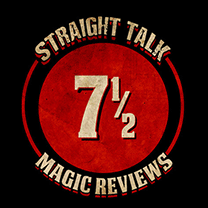 The Collection is a collaboration by prolific mentalist, Kenton Knepper and his student, Luca Volpe, who is a top-notch mentalist in his own right. The book contains four effects and touches upon the philosophy of and approach to mentalism and its underlying psychology. Although the book is very short, some of the topics covered are deep and potentially powerful material with the right presenter and spectator.
The Collection is a collaboration by prolific mentalist, Kenton Knepper and his student, Luca Volpe, who is a top-notch mentalist in his own right. The book contains four effects and touches upon the philosophy of and approach to mentalism and its underlying psychology. Although the book is very short, some of the topics covered are deep and potentially powerful material with the right presenter and spectator.
The first routine, “Headline Prediction”, is more of a standard magic trick compared to rest of the book. In Headline Prediction, the magician meets with a spectator a week before the show (in a corporate event or private party) and hands him a sealed envelope. The spectator signs the outside of the envelope and on the day of the show, the performer has the spectator deliver the sealed envelope to him. The performer then takes a newspaper, from the day of the show (and one week after the envelope is sealed and signed) and has words from a randomly torn piece of the newspaper selected. When the envelope is opened during the show, it contains a non-gimmicked DVD, which is played on a real DVD player. The DVD contains a recording of the magician speaking to the camera and he names the randomly selected words and describes the headline on the newspaper from that very day, even though the DVD was removed from the sealed envelope that the spectator signed the week before. The ad copy incorrectly states that “the performer never touches” the envelope. That is not accurate, but the audience will believe that to be true. There is an interesting discussion about the effect, its psychology and why the audience cannot fathom the method behind the effect.
The next routine is “Psychic Vision.” The authors indicate that this effect is not for everyone and I believe that comments also applies to the third and fourth effect as well. This effect is a different and more serious act of mentalism that requires a keen understanding of the psychology of mentalism and how to read a spectator. If this effect works, it places the performer in a position of power as he is truly believed to have been able to foretell the future. In this routine, the performer gives the spectator a letter in a sealed envelope and instructs the spectator to open it in one week, at which time the spectator will speak with the performer and then give the spectator something of importance. This effect discussed Hoo Doo and Mojo bags and non-mainstream magical methods. The next two effects, “Divinatory Message” and “Symbol Cubes” are more similar to Psychic Vision than Headline Prediction in that the effect, when successful, has the spectator actually believing that the performer has occult powers. Both effects again require the performer to have the honed ability to read spectators and respond to their cues, which is a talent and skill that is discussed. In Symbol Cubes, dice with images (not dots) are rolled by the spectator. The performer then explains how the images are relevant to the spectator in a tarot card-like reading — but with dice instead.
Although the book has some typos and at times it is a bit wordy, it has some interesting ideas and effects for mentalists. Volpe offers his personal email to the reader asking for feedback and in fact when I emailed him a question and a suggested adaptation to the Headline Prediction, he responded within a few hours and commented on my suggestion, which was a method to turn the Headline Prediction into more of an impromptu effect, without the need to mail the envelope a week in advance.
Although the price tag is high for such a small book, the material is provocative, challenging and thought-provoking. If you have an interest in mentalism from some current authorities in the field, this book is a worthwhile read.